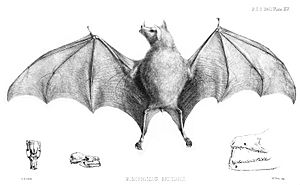Leach's single leaf bat facts for kids
Quick facts for kids Leach's single leaf bat |
|
|---|---|
 |
|
| Conservation status | |
| Scientific classification | |
| Genus: |
Monophyllus
|
| Species: |
redmani
|
The Leach's single leaf bat (Monophyllus redmani) is a type of bat found in the Caribbean. It is also known as the Greater Antillean long-tongued bat. These bats live in places like the southern Bahamas, Cuba, Jamaica, Hispaniola (which includes Haiti and the Dominican Republic), and Puerto Rico. They live in very big groups, sometimes with hundreds of thousands of bats! Leach's single leaf bats eat many different things, including pollen, nectar, fruit, and insects.
Contents
About the Leach's Single Leaf Bat
The Leach's single leaf bat is the biggest bat in its group, called Monophyllus. It grows to be about 73 to 80 millimeters (about 3 inches) long. An adult bat usually weighs around 8.8 grams, which is about the same as two quarters.
This bat has light brown or gray fur. It has a special nose leaf and a long snout. Its tongue is also very unique! It has tiny bumps, called papillae, that can stand up. This helps the bat collect pollen from flowers like a tiny mop.
Scientists have found old bones of these bats in caves. These fossils show that they have been around since the Pleistocene and Holocene periods.
Where These Bats Live
Leach's single leaf bats live across the Bahamas, Cuba, Jamaica, and Puerto Rico. They gather in huge numbers inside caves to rest and sleep. Some of these bat colonies can have hundreds of thousands of bats living together!
In Jamaica and Cuba, these bats were found in damp caves. In the Bahamas, they preferred caves with good air flow. A study in Puerto Rico in 1998 found that these bats often roosted in warm caves. They were found in 31% of all caves surveyed.
These bats often share their cave homes with other types of bats. They commonly live with the Jamaican fruit bat, the Antillean ghost-faced bat, and the sooty mustached bat. They seem to like deep parts of caves and areas with stalactites. The warm caves they use all year round can be very hot, from 26 to 40 degrees Celsius (79 to 104 degrees Fahrenheit). These caves usually have only one opening and special dips in the ceiling. Scientists think the bats like these warm spots because it helps them save body heat.
What Leach's Bats Eat
The Leach's single leaf bat eats nectar, fruit, and insects. Most of their diet (91%) comes from nectar, which they get from flowers like guava and wild tamarind. About 22% of their diet is fruit, such as Panama berries. They also eat insects, especially soft-bodied ones like moths and flies.
Compared to other bats in the Caribbean, the Leach's single leaf bat has a jaw that is better for eating nectar than fruit. They get important nutrients, like nitrogen, mostly from pollen and insects. Having a varied diet helps these bats survive big events like hurricanes. They can recover faster than other bats because they can find different kinds of food available at different times.
Sometimes, the Leach's single leaf bat shares its habitat with another bat called the brown flower bat in Puerto Rico. Studies show that Leach's bats eat more insects, while brown flower bats eat more plants. This might be a way for them to avoid competing for the same food.
Bat Health and Parasites
Scientists have studied the tiny creatures that live on and inside bats, called parasites. They compared three types of bats, including the Leach's single leaf bat. They found that if a bat had many parasites on its skin (ectoparasites), it usually had fewer parasites inside its body (endoparasites).
The Leach's single leaf bat had the most ectoparasites, but it did not have any helminths (a type of internal worm parasite). These bats all live in the same caves. Scientists think that the differences in parasites might depend on where exactly each bat species chooses to rest inside the cave, as different spots can have different temperatures and conditions.
Protecting These Bats
The Leach's single leaf bat is listed as "Least Concern" by the IUCN. This means their population is large and they are found in many places. However, activities like mining and tourism are slowly reducing the number of caves where these bats can live and roost.
See also
 In Spanish: Monophyllus redmani para niños
In Spanish: Monophyllus redmani para niños


